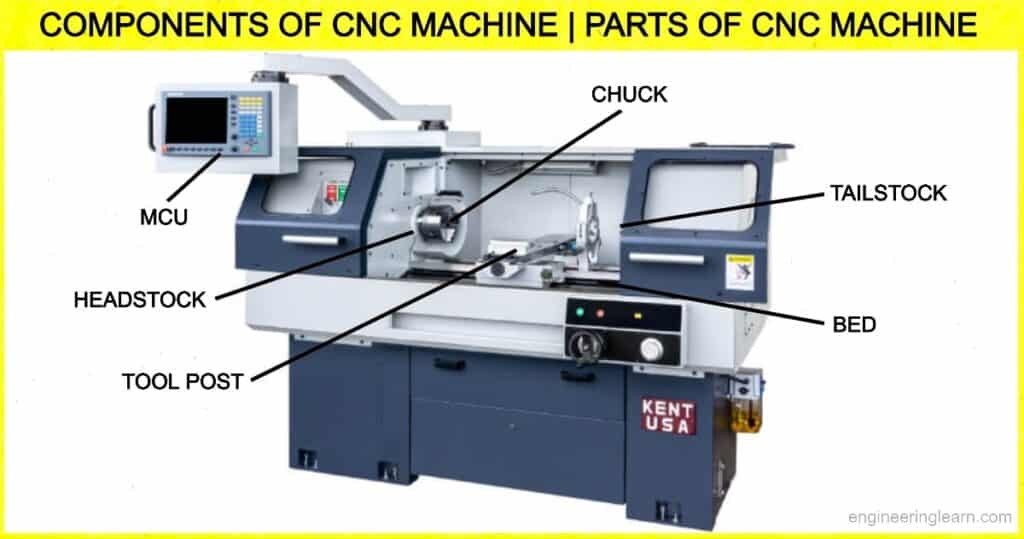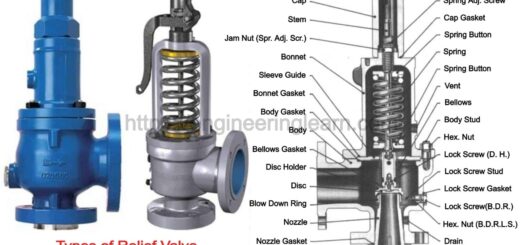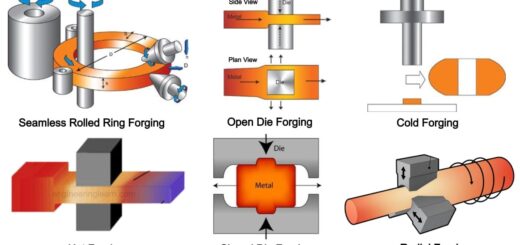Components of CNC Machine | Parts of CNC Machine

Introduction
Components of CNC Machine | Parts of CNC Machine: – CNC machines are computerized machines that assume a significant part in the manufacturing industry and provide more steady, effective, and precise outcomes than the manual processes. These machines are not just really good for complex cutting and manufacturing a wide variety of things yet additionally for wiping out the risk of human error. CNC machines utilize a software programming language called G-code, which is written in a simple and logical way.
It tells the machine the specific measurement for production – explicitly the feed rate, speed, location, and coordination – which permits the machine to be flexible and consistent in producing various parts. The CNC machine should be precise and accurate. Accuracy makes a CNC machine so flexible and effective. The computer can send the control system through a progression of coordinates generated by the computer-aided design or CAM softly.
Therefore, it is critical to ensure that your CNC machine is set up accurately and that the portion of the material you wish to eliminate or remove doesn’t go amiss from your desired line.
Components of CNC Machine
1. Central Processing Unit (CPU): ( Components of CNC Machine )
A CNC system is controlled by the CPU or the core of the system. It is where the information is stored in the memory as a part program is received. After the information is acknowledged, the computer processor decodes and changes this data into explicit position control and velocity control signals.
2. Memory Controlled Unit (MCU): ( Components of CNC Machine )
The MCU (machine control unit) is the set of electronic equipment and software that peruses the G-code supplied by the input device and makes an interpretation of it into instructions that can be executed by the tool drivers to play out the desired machining actions. It is one of the main CNC machine components. The MCU interprets or deciphers the G-code coordinates into movements carried out by servo motors along the different machine axes.
3. Programmable Logic Controller (PLC): ( Components of CNC Machine )
A PLC is an industrial strong state computer that matches the NC to the machine, which follows a pre-modified set of rules and yields in light of contributions to control systems and go with logic-based decisions for the CNC machine. It is utilized to limit manual operation and can endure harsh conditions like outrageous heat, cold, dust, and dampness.
4. Machine Control Panel: ( Components of CNC Machine )
A machine Control panel is a flat area where controlling, monitoring, or managing instruments are displayed, filling in as the direct interface between the operating system and the NC system. Before a program is executed, the machine ought to be prepared as far as loading the system memory with the required part program, laying out the right reference point, and other essential commands.
5. Machine Tool: ( Components of CNC Machine )
Machine tools is the general term used to allude to any tool that might play out a process on a workpiece, normally cutting tools. Machine tools take on many forms relying upon the type of CNC machine. CNC lathes utilize stationary tools and move the spinning raw material into the tool to make cuts. CNC mills move spinning tools into stationery material. A tool changer naturally eliminates a tool from the spindle, places it in the tool library, and installs the next tool.
6. Input Devices: ( Components of CNC Machine )
The “input device” for a CNC machine is the means by which CNC programs are loaded or stacked into the machine. This input device could be the keyboard (to straightforwardly enter G-code commands), a USB flash drive (to transport a completed program from another PC), or wireless communication (on the off chance that the program is to be downloaded from another computer utilizing the local network).
7. Servomotor: ( Components of CNC Machine )
It likewise works like that of a stepper motor however, there is a fast action braking mechanism accessible in the engine so that at whatever point the power supply is getting halted, the braking mechanism will be activated and shut down all the moving parts.
Thus getting the high positional accuracy of the machine is conceivable. Since the Servo Engines are not accessible at the hour of improvement of the NC machine, the stepper motor can be utilized as a drive unit.
8. Servo Control Unit: ( Components of CNC Machine )
The servo control unit is liable for exact position control as it receives the position feedback signals for the actual movement of the machine tool axes from the feedback devices. It creates reasonable signals as command values, which are interfaced with the axes and the spindle motors.
9. Feedback Devices: ( Components of CNC Machine )
The feedback devices, which are likewise referred to as the measuring system, comprise position and speed transducers that go about as sensors to monitor the current position of the cutting tool at any moment.
10. Feedback System: ( Components of CNC Machine )
In spite of the precision or accuracy of the driving system, it might in any case be important to have a closed-loop control system so that the goal after the machine moves a mechanical component to a particular position, this position is verified and, if necessary, changed or adjusted.
11. Display Unit: ( Components of CNC Machine )
The display unit is a monitor or an interactive device between the machine and the operator which shows the current status of the projects, orders, and other important information of the CNC machine. It can likewise be valuable for upkeep and establishment work since it can show other significant information.
12. Driving System: ( Components of CNC Machine )
In the CNC mill, the bed is moved evenly along the x-and y-axes and the cutting tool or apparatus is moved up along the z-axis. In a standard CNC lathe, the driving system moves the cutting tool co-linearly with the axis of workpiece rotation. The cutting tool is moved into the external diameter of the material along the rotational axis of the workpiece along the rotational axis.
The movement in a CNC machine is many times controlled or constrained by servo motors, ball screws, and linear guides. Servos can precisely move the ball screw nut to position the different mechanical components like the bed and the spindle.
13. Bed: ( Components of CNC Machine )
A CNC mill’s bed is where the natural substance is mounted. Different work-holding jigs are utilized to secure the workpiece set up at a place. The bed often has t-slots or openings to which the jigs can be attached. Conventional CNC machine beds just along the horizontal x-and y-axes, yet further developed 5-axis machines can include rotational motions along the x-and y-axes.
14. Headstock: ( Components of CNC Machine )
The headstock is a segment unique to a lathe that contains the principal drive, bearings, and gears needed to turn the chuck at the required speeds for machining. The headstock can be situated or found on the left-hand side of a CNC machine. The headstock is typically enclosed and is gotten to through removable inspectional panels.
15. Tailstock: ( Components of CNC Machine )
The tailstock is a CNC machine part or lathe that is utilized to pivotally support long, cylindrical workpieces on one side while the chuck upholds the opposite side while likewise rotating the material. Without the tail stock, the forces created during cutting or slicing will make the material deflect away from the cutter. The raw material is centered on the tailstock quill which pivots freely in the tailstock. It is particularly valuable for cutting parts like power screws or shafts.
16. Tailstock Quill: ( Components of CNC Machine )
The tail-stock quill is situated in the tailstock, the quill has a cone- shaped end that is collinear with the spindle and chuck axis. While machining a long shaft, a blind hole is frequently drilled into the center of the end of the workpiece so the quill can be positioned into it for support. The tailstock is moved near the part, then, at that point, the quill is actuated with pneumatic or hydraulic pressure to secure the raw material.
17. Footswitch or Pedal: ( Components of CNC Machine )
Foot pedals are utilized to activate and deactivate the chuck and tailstock quill of a CNC lathe. CNC mills don’t regularly have foot pedals as the parts are as of now supported on the bed and the operators don’t have to have two hands-free while loading and unloading raw material.
18. Chuck: ( Components of CNC Machine )
The chuck is a machine-specific part that is utilized to grip the raw material while it is being machined on a lathe. It is rotated or turned at a fast or high speed by the axle. A chuck normally has three or four pneumatically or hydraulically actuated grips. Three-jaw chuck grips are self-focusing. Every type of grip moves radially simultaneously. The grips on four-jaw chucks can be exclusively adjusted or changed, and are not self-centering. They consider eccentric cutting, as their position can be precisely controlled to account for any variation in the unrefined substance.
Conclusion
The CNC machine is an exceptionally flexible tool. It tends to be utilized to cut, engraves, and mill various materials like plastic, aluminum, and different metals. Its versatility implies that you can use it in different applications and, even in, industries, for example, automotive, construction, and aviation ventures. It is an exceptionally valuable tool and today’s market has a sizable amount of CNC machines for you to look over. Notwithstanding, you want a precise, reliable machine that gives you the ideal outcomes.
Content Source: – tramarindustries, gemsons, xometry
Image Source: – mellowpine













